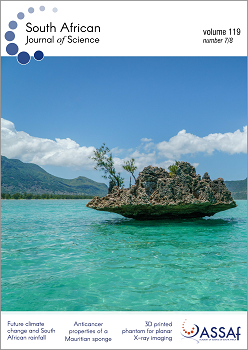Future climate change in the Agulhas system and its associated impact on South African rainfall
DOI:
https://doi.org/10.17159/sajs.2023/13733Keywords:
Agulhas system, South African rainfall, climate change, CCSM4, CMIP5Abstract
South African climate variability has been linked to changes in both the Agulhas system and external forcing (i.e. CO2 and ozone). We analysed future climate change in the Agulhas system volume transport and its associated impacts on South Africa’s precipitation using the Community Climate System Model version 4 as part of the Coupled Model Intercomparison Project, phase 5. Output from one historical and three future greenhouse gas emission scenarios were examined to project various climate storylines. We found that the Agulhas Current volume transport decreases across all three scenarios and that the current displays a strong baroclinic component with an increase in transport at the surface and decrease at intermediate depths. Agulhas leakage was found to increase with historical emissions. Additionally, an east-west dipole pattern for convective precipitation was found over South Africa, with an increase over the eastern region related to an increase in greenhouse gas emissions and a decrease in the western region linked to the location of Hadley cell edge latitude. Moving into the 21st century, future predictions in regional climate variability are shown to be dependent on the intensity of greenhouse gas emissions and are extremely important for South Africa, a region prone to drought and flooding and home to a large population dependent on rain-fed agriculture.
Significance:
- Future climate variability in the Agulhas system and South African region is heavily dependent on changes in external forcing.
- The Agulhas Current volume transport decreases as the greenhouse gas emissions continue to increase and a strong baroclinic component is found with an increase in transport at the surface and a decrease at the intermediate depths.
- A strong east-west dipole precipitation pattern is found over South Africa with the increase in the eastern region related to the increase in greenhouse gas emissions and the decrease in the western region related to the location of the Hadley cell edge latitude.
Published
Issue
Section
License

All articles are published under a Creative Commons Attribution 4.0 International Licence
Copyright is retained by the authors. Readers are welcome to reproduce, share and adapt the content without permission provided the source is attributed.
Disclaimer: The publisher and editors accept no responsibility for statements made by the authors
How to Cite
- Abstract 1068
- PDF 588
- EPUB 171
- XML 224
Funding data
-
National Oceanic and Atmospheric Administration
Grant numbers NA18OAR4310293;NA15OAR4320064 -
National Science Foundation
Grant numbers OCE1419569;OCE1559151 -
U.S. Department of Energy
Grant numbers DE-SC0019433












.png)